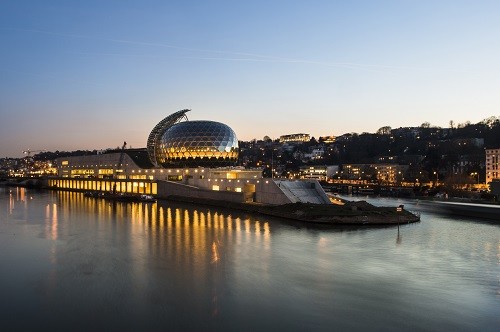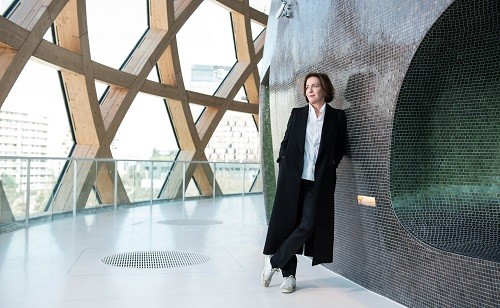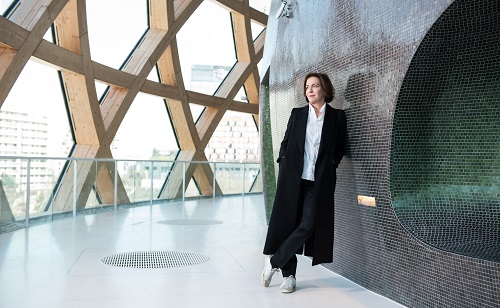Laurence Equilbey on La Seine Musicale, Insula Orchestra
and Female Composers

The approach to Paris’s newest concert hall complex, La Seine Musicale, is highly impressive, to say the least. Located on an island in the Seine – Île Seguin, to the west of Paris – this complex contains not one, but two halls: a 1150-seat auditorium for classical concerts, and a 6,000-seat arena. A collaboration between Japanese architect Shigeru Ban and French architect Jean de Gastines, the glass-and-timber complex also boasts no fewer than five recording studios, plus practice rooms and a rooftop garden. There is also a mobile ‘sail’ of photovoltaic panels which moves in response to the sun and provides power for the complex during daylight hours. It was here that we, a small shrivel of critics, were to hear Laurence Equilbey conduct Insula Orchestra in its new, fresh concert hall.

Inevitably, La Seine Musicale forms the starting point of my conversation with Laurence Equilbey, an interview held in an office in the administration section of the complex. She asks is it my first time here (to the concert hall), referring to La Seine Musicale as ‘très inspirant’ – ‘very inspirational’. There’s an equally inevitable question, given that that night’s programme comes to the Barbican on March 8: has she ever conducted at the Barbican before, and how did she find it? Once before, apparently: ‘very good, wonderful’ comes the diplomatic reply.
I want to take in a little of Equilbey’s history first. I’m sure readers will be familiar with her work with the Accentus choir; but what about the orchestral side of things? Was it choral music that came first?
‘Actually, I studied orchestral direction in Vienna, and there as a student I sang in the Arnold Schoenberg Choir, and I was very impressed with this chamber choir. And then in Paris I continued to study orchestral conducting but at the same time I founded Accentus.’ Foregrounding Equilbey’s excellence as an orchestral trainer and interpreter of the symphonic repertoire, then, gives us a much more rounded appreciation of Laurence Equilbey, the musician.
The inclusion of Louise Farrenc’s Third Symphony is part of an ongoing project of the Insula Orchestra and Equilbey to highlight women composers, and to point out the continued injustices not only for the music of Farrenc, but also the likes of Fanny Mendelssohn-Henselt and Clara Schumann, plus other lesser-known names. ‘I think it is very important to play these pieces from the past because there are some great works. Actually, Farrenc composed three symphonies and two overtures, all of which are very fine and very beautiful. They are elaborated in a very German way because her teacher was Anton Reicha, so she has this German way in her style. Next year I will also conduct the Clara Schumann Concerto [soloist yet to be decided – ed] and Fanny Mendelssohn’s Hero und Leander, a beautiful piece with a soprano soloist. At the moment I am very interested in Clémence de Grandval (1828-1907), who composed a lot of operas, a little bit later than Farrenc. Each time I try to put the spotlight on someone different, as always we are playing a lot of male composers – that’s normal, that’s the main repertoire.’
Moving to the symphony we are about to hear tonight, Louise Farrenc (who was born Louise Dumont before marrying the flautist Aristide Farrenc) studied privately with Reicha (a composer whose works are being re-evaluand themselves, thanks to the keyboard recordings on Chandos). Farrenc clearly went on to develop a distinctive voice, one I hear particularly in the naturally unfolding Andante of the Second Symphony, the precursor to the symphony played at La Seine Musicale. Laurence Equilbey says of Farrenc: ‘she has a sort of lyricism, like Schumann, especially in the second movement of the Third Symphony, beautiful. She writes for the strings a little bit like the piano, it’s like a great garland, very beautiful. Very inspired.’
But Farrenc wasn’t allowed to study harmony in Paris? ‘It was forbidden. What is very interesting is that Reicha, with whom she had private lessons, was famous for his knowledge of wind instruments, and also her husband Aristide Farrenc, was a flautist, so she is very good with the woodwinds. That was a little bit of a problem with a female composer at that time because the winds for them were difficult, but for Farrenc it was her forte.’
Related to this, on a feminist perspective, would be the work Equilbey did in Paris and Vienna with Goethe’s play Egmont and Beethoven’s incidental music; I’m thinking here of the character of Klara, who wants to be a man so she can go out and fight (which itself has resonances of Leonore Fidelio who has to enter a man’s world to save her husband …). ‘Egmont was a staged version, it was very interesting and especially as Klara was very much a feminist in that version. Also, it is very important for us here because we invite ensembles and orchestras and also conductors and soloists and try to have a good balance between male and female artists.’
So, is the idea to explore the balance between the male and the female in your programmes? ‘The idea is to promote the idea that we want to have more equivalence onstage. It cannot be 50-50 because of the history but we try to have a good representation of the female energy.’
And what about Equilbey’s work with contemporary female composers? ‘I’ve done a lot, I’ve conducted, amongst others, Betsy Jolas, Kaija Saariaho, also Francesca Verunelli, whose music is very good. I try to include new pieces to achieve a good balance. In the case of Saariaho, we have a performance of her music in two years’ time.’
When we look at earlier works, by composers such as Louise Farrenc, we have a tendency to link them to other composers – I hear some Mendelssohn, here, some Beethoven, some Schumann there (as I do in my review, for example); ‘It’s not a ‘new’ past but it’s important in the corpus of that time. In the second movement [of the Third] she opens up new lyricism’
I ask: it is that lyricism what gives her her individuality? ‘More in her chamber music. Yesterday we played a Trio [in E minor for flute, piano and cello] and the Sextet [in C minor, for piano, flute, oboe, clarinet, bassoon and horn], it’s very refined and well written with a lot of ideas. I think she had more time to practice the chamber music. For example, the Third Symphony was only performed twice in her lifetime, it’s not a lot to make changes.’
Farrenc’s particular individuality is ‘also with the rhythm, she has a lot of ideas with the rhythms, and it’s sometimes very tricky’.
And what is the advantage of having a period instrument orchestra for these performances?
‘It can be heard especially in the winds as they have special colours, and for the balance. The timbres mix more easily, like an organ.’ And natural horns? ‘Yes, and it is difficult as you have horns in G, which can be very tricky. For the strings, one can more easily sculpt the lines, it is fresher’ And the textures, are they clearer? ‘Exactly’.
Are you going to record the Farrenc? ‘I don’t know, I will think about it. The boss from Erato is here today so perhaps we will speak about it. Either way, we will have a video of tonight available in due course.’
Talking of pieces that require more exposure, the Farrenc is coupled with Beethoven’s Triple Concerto, a piece which itself could get out more. Equilbey has two different piano soloists for the Paris and London performances, David Kadouch and Alice Sara Ott respectively, ‘because we were asked for three female soloists by Paul Keene [of the Barbican]’ So, naturally, David doesn’t qualify … It’s also a particularly difficult concerto, particularly for the cello.’ How much rehearsal time? ‘A lot of time. Two months ago, the soloists had two days to get to know each other, I met them 2 weeks ago, and we took time to get to know each other …’
The Insula Orchestra was founded in 2012, and has already made several recordings. ‘The idea in 2012 was to build this orchestra to come here to La Seine Musicale in 2017. The idea for me, because I studied with Harnoncourt in Vienna, I like very much the music of the 18th century and beginning of the 19th century with period instruments. I like the sounds and sonorities, and for Mozart and Haydn I prefer it. I didn’t have so many chances to conduct period instruments as all the orchestras have their own conductors. I conducted the Orchestra of the Age of Enlightenment once, also the Akademie für Alte Musik Berlin, and Concerto Köln, but a maximum of once per year. So, I decided to create my own orchestra with period instruments and also to do my projects, but also to invite conductors. In January 2017 for example, we invited Leonardo García Alarcón, and next season we will work with Christian Zacharias and later Duncan Ward, for example’
The orchestra is very linked to the venue, then? ‘We play our concerts and productions here, we have an invited guest season, which is very rare. La Seine Musicale was always meant to be the home of the orchestra, we play 30 evenings, the other days are programmed privately’
I like the period instrument approach but also the way it is married to a very contemporary, digital means of getting the message out there ‘The values are all about innovation and openness.’ There is a stunning photo from the Insula performance of Haydn’s Creation on the wall, which goes to New York in July. ‘I like very much new things, and the risks. I think with period instrument sonorities this sort of’ [makes a roaring sound] ‘goes very well with the raw sound.’
It certainly does. Hearing Insula on its home turf was a delight (review); I await the Barbican performance on March 8 with some impatience.
Colin Clarke
For more information go to:
http://laurenceequilbey.com/en/

I highly appreciate Laurence Equilbey’s beautiful and ample conducting work, but I think she would do even more and better if her prime love was music instead of the political agenda of demanding that women have not only equal rights but, blindly and unconditionally, equal place in society.